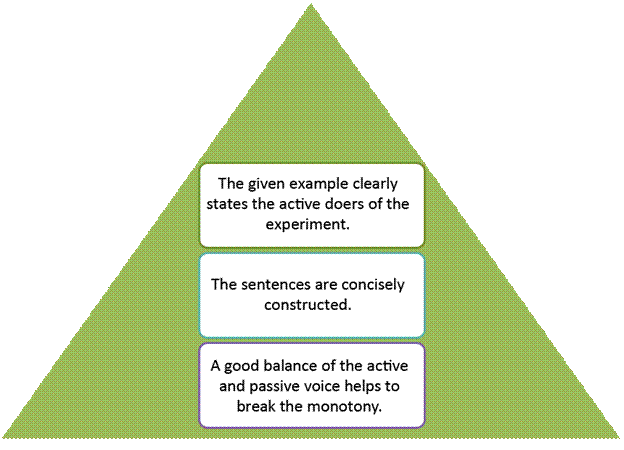A sentence is in passive voice when the subject of a sentence is the object being acted on. Active voice, on the contrary, is where the subject performs the action. Through the 20th century, passive voice was the prevalent linguistic feature of scientific writing. However, there has been a distinct shift in consensus in the 21st century. Most writing guides (such as the APA [6th edition, section 3.18]) support the active voice for clarity and brevity. The general opinion among scholars is that the passive voice makes writing flat and implies evasion of responsibility in writing of any form, not just scientific writing.
Various tools are available nowadays to help authors write in consistent voice and tense. One of the recommended tools is Trinka – world’s first language enhancement tool, specially designed for scientific writing. Along with grammar and language corrections, Trinka provides subject-specific suggestions too. It also recommends phrasing preferred by most widely used style guides, which is an important aspect of technical writing.
APA, a widely used style guide, advises that verb tenses and voices should be used judiciously. The active voice can be used primarily in the Discussion section where it is important to convey that it is you supposing certain things and having particular assessments. In the Methods section, it is acceptable to break the monotony of several passive voice sentences with the use of the active voice. A response on Quora (John Geare, 2015) succinctly sums up the required balance:
In academic writing, passive voice is used to describe a process, the results of study, or similar material which is objective in nature. But active voice is used to describe actions.
John Geare provides a specific example for clarity.
My colleagues A, B, [names changed] and I, designed an experiment to test the impact on worker perceptions of well-being when domesticated cats were allowed to freely roam various work environments in which the subjects were normally employed. Three test environments were selected for our experiments: a law office, a laboratory in which experiments were performed using laboratory rats, and an automobile assembly line. One-way mirrored glass panels were installed to allow video cameras to record the activity, and researchers to observe the same and take notes. We secretly inserted observers directly into the work environment. These observers posed as outside contractors, and were uniformed as maintenance and cleaning staff, coffee and water service vendors, and similar supporting personnel. The observers were drawn from the students who were matriculated into the experimental psychology courses from which this study had been developed as an example of such studies generally.

You can check the references for further information on the use of the active and passive voice across writing styles and domains.
Besides, if you are looking for an AI-driven writing tool to enhance your writing, then check out Trinka. It has several exclusive features to make your manuscript ready for the global audience.
References:
- Ding (1998), “Rationality reborn: Historical roots of the passive voice in scientific discourse”, in J.T. Battalio ed., Essays in the Study of Scientific Discourse: Methods, Practice, and Pedagogy, Ablex, Stamford, CT, pp. 117–135.
Vijith Assar (2015, September 3) An Interactive Guide To Ambiguous Grammar. Retrieved from https://www.mcsweeneys.net/articles/an-interactive-guide-to-ambiguous-grammar
Josh Bernoff, WOBS LLC (2016, April 26) A passel of pernicious passive voice (Master Post). Retrieved from http://withoutbullshit.com/blog/master-post-passel-pernicious-passive-voice
Duke University Scientific Writing Resource. Passive Voice in Scientific Writing. Retrieved from https://cgi.duke.edu/web/sciwriting/index.php?action=passive_voice
Leong Ping Alvin (2014, March 13) The passive voice in scientific writing. The current norm in science journals. Retrieved from https://jcom.sissa.it/sites/default/files/documents/JCOM_1301_2014_A03.pdf
Language and Learning Online. Active or passive voice? Retrieved from http://www.monash.edu.au/lls/llonline/writing/general/lit-reviews/5.xml
John Geare (2015, August 29) Why shouldn’t we use a passive voice in academic writing? Retrieved from https://www.quora.com/Why-shouldnt-we-use-a-passive-voice-in-academic-writing


Good web site you have here.. It’s hard to find excellent writing like yours these days. I honestly appreciate individuals like you! Take care!!|
Have you ever thought about including a little bit more than just your articles? I mean, what you say is important and all. But just imagine if you added some great images or video clips to give your posts more, “pop”! Your content is excellent but with images and clips, this blog could undeniably be one of the best in its niche. Wonderful blog!
wow, awesome article. Fantastic.
A big thank you for your article.Really looking forward to read more. Fantastic.